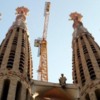You don't have to have visited Barcelona to recognize the outside of Antoni Gaudi's Sagrada Familia basilica; it's easily one of the world's most recognizable churches. In recent years, the interior has also opened, but it's easy to miss one of the highlights: The museum tucked away under the church.
The exhibits on the lower level focus not only on the history and structure of the church, but also on Gaudi's methods and ideas, and the changes in his designs over the 43 years he worked on the building, between 1883 and 1926.
Much of the work in the crypt and other lower spaces had already begun by Francisco del Villar in the year before Gaudi took over; del Villar envisioned a classically Gothic cathedral, quite unlike the mix of Gothic proportion and Art Nouveau forms we see today.
The heart of the museum is the recreation of Gaudi's workspaces in the building, and the models he used to develop the plans. Much of that was destroyed in a fire set during the Spanish Civil War in 1936, and years were spent piecing together fragments and re-creating from notes and photographs. The image above represents Gaudi's desk space and tools.
Gaudi's working methods as an architect were as unusual as his designs. In an age where fine draftsmanship and detailed plans had become the norm, even blueprints, Gaudi worked most often with carefully-made models, often in plaster. Although he was a skilled draftsman he preferred the models that allowed him to visualize, test and adjust shapes and weights and then to serve as guides for construction.
Models for the shape of the sacristies, and one of several models for the naves, each one opening more space and height than the previous.
For me, the most stunning example of models was the string model above, made not for Sagrada Familia but for another church he was designing for Colonia Guell. The hundreds of weighted strings create the shape of the church, but inverted! The lower photograph is the source from which the model above was re-created. George G was able to identify our One-Clue Mystery site from the image.
Perhaps ironically, just around the corner from the exhibit of Gaudi's models today's modeling shop is on view; time has swung around to Gaudi's methods, but now using large 3-D printers in place of plaster models, but with the same purpose!
A narrow tubular bell Gaudi designed for the 7-octave carillon that is spread through the towers. This one, an original, was rung at Gaudi's funeral in 1926. Below, the consecration by Pope Benedict in 2010.
Sagrada Familia is not Gaudi's work alone, although his vision is everywhere in it. Other architects and artists have continued the construction. As you might expect, some are pleased with the work, and others upset that things might not be exactly as Gaudi envisioned them. Gaudi knew that would happen, and the exhibit includes two quotations from his writing:
It is not a disappointment that I will not be able to finish the Temple. I will grow old, but others will come after me. This will make it even more grandiose."
I know the personal taste of the architects that follow me will influence the works but that doesn't bother me. I think the Temple will benefit from it. Great temples have never been the work of just one architect."
Two of the artists who have figured heavily in the years after Gaudi are featured in the museum, one for his work on the stained glass, and the other for the massive sculptures of the facades left unfinished by Gaudi. The images just below show Catalan artists Joan Vlia-Grau and his glass workshop.
Much of the controversy over recent work has focused on the sculpture work of Josep M. Subirachs, a Catalan sculptor named by the commission that oversees the construction; As Gaudi predicted, the taste of other artists would enter the work, as Subirachs' emotional and expressive but harsh work, below on the Passion Façade, shows.
And yet, perhaps it is not so different as first glance seems: In 1902, Gaudi described his vision for the Passion Façade:
Some may find this doorway too extravagant. But I wanted to inspire fear, and to do so I used plenty of chiaroscuro, recesses and protrusions, all of which provided a gloomy effect.
Perhaps the best part of this museum, then, was not only learning about Gaudi's methods and the building's details, but understanding a great artist's willingness to completely immerse himself in the project and the vision, and then to let it live in the hands of others.



Comments (0)